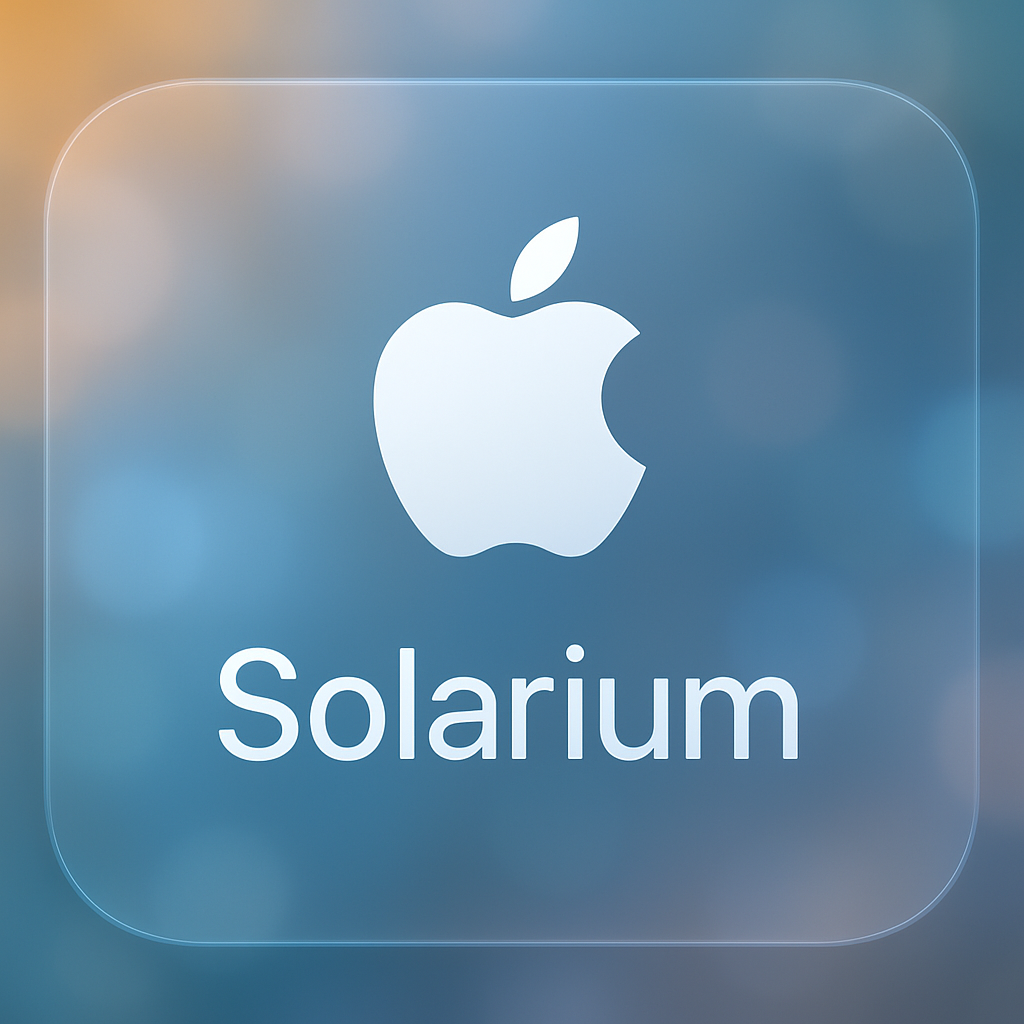Apple’s “Solarium” UI Overhaul: What to Expect at WWDC 2025
Introduction: Apple’s Bold UI Shift at WWDC 2025
According to multiple sources, Apple is gearing up for a major user interface redesign across all its operating systems, codenamed “Solarium”, set to debut at WWDC 2025. This overhaul is the most significant visual update since the 2013 launch of iOS 7, aiming to unify the look and feel of iOS, macOS, iPadOS, tvOS, watchOS, and visionOS under a single, modern design language inspired by Apple’s spatial computing platform.

What Is Solarium? The Design Philosophy Behind the Name
The name “Solarium” references glass rooms designed to flood interiors with sunlight. This perfectly reflects the core design theme:
- A semi-transparent, frosted glass aesthetic, drawing heavily from visionOS’s layered, spatial UI.
- UI elements with translucency and depth, creating a sense of floating and layering.
- More rounded, “squircle” style app icons to harmonize across devices.
- Subtle motion effects reacting to user interactions for a dynamic and immersive feel.
This glass-like, light-filled design aims to deliver a cohesive, elegant user experience that feels consistent whether you’re on an iPhone, Mac, Apple Watch, or Apple TV.
How Solarium Changes Each Platform
Apple isn’t just applying a one-size-fits-all skin; it’s tailoring Solarium’s elements to each OS while driving toward a shared visual language:
- iOS & iPadOS: Expect the most dramatic shifts — search bars moving to the bottom for easier reach, rounded corners everywhere, and UI components inspired by visionOS translucency.
- macOS: Moves closer to the iPad experience in look and feel but retains desktop fundamentals, blending consistency with platform-specific strengths.
- tvOS: Its first major redesign since 2015, possibly dropping support for older Apple TV HD models, adopting the Solarium aesthetic for a fresh, modern TV interface.
- watchOS: Gets visual updates to better align with iOS, making the Apple Watch UI feel more integrated with the rest of Apple’s ecosystem.
- visionOS: Mostly stable but with minor tweaks to fit the broader Solarium theme.
This approach signals Apple’s strategic move towards spatial computing principles — layering and depth — even on traditional flat-screen devices.
Apple’s UI Focus vs. AI Race: A Strategic Contrast
While Google and Microsoft are loudly spotlighting AI breakthroughs at their recent conferences, Apple’s WWDC 2025 will put user interface design front and center, with AI features playing a more modest supporting role:
- Introduction of “Apple Intelligence” brand features.
- Opening up internal large language models to third-party developers.
- Collaboration between Siri and Google’s Gemini model.
However, these AI moves are more incremental compared to the sweeping AI advances from competitors. This choice underscores Apple’s long-held philosophy of prioritizing polished, user-centric experiences over hype.
Why This Matters: Practical Implications and Predictions
- User Experience Consistency: If Apple nails Solarium, switching between devices will feel more intuitive and seamless than ever, reducing cognitive friction for users embedded in the Apple ecosystem.
- Design as Differentiator: With many tech firms racing for AI leadership, Apple’s focus on design polish could appeal to users craving refinement over raw feature bloat.
- Spatial UI Influence Grows: VisionOS-inspired design language may slowly permeate all Apple devices, subtly preparing users for a future where spatial and immersive computing become the norm.
- Legacy Device Impact: Older devices like Apple TV HD might be left behind, nudging users toward newer hardware — a familiar but sometimes frustrating pattern.
- Developer Impact: A consistent UI across platforms could simplify app design and maintenance but may require developers to rethink layouts to fit new paradigms like bottom search bars.
The Big Picture: Solarium at WWDC 2025
The Worldwide Developers Conference runs June 9-13, 2025, with the keynote on June 9 at 10 AM PDT. Apple will live-stream the event broadly, making the Solarium unveiling accessible worldwide.
Unlike the iOS 7 redesign that was mostly iPhone-focused, Solarium is a sweeping overhaul touching every major OS simultaneously — a bold move that underlines Apple’s renewed emphasis on design coherence across devices.
While this may not be the “AI revolution” headline some expect, it’s a strategic, thoughtful evolution that puts Apple’s strengths front and center: clean, usable, beautiful interfaces that just work.
A Wish for the Future: More Desktop Power on the iPad Pro
With Apple finally consolidating design across all its platforms, here’s hoping the iPad Pro starts to get some much-needed love beyond just aesthetics. The iPad packs the same powerhouse chips found in the MacBook Air — machines that can effortlessly run heavy-duty desktop apps, local large language models, virtual machines (yes, even Windows), and more.
So why does the iPad still feel like a glorified, big iPhone? It’s about time Apple starts unlocking that raw power for pro-level workflows, not just touch-friendly apps. If Solarium is the start of deeper convergence, maybe this year we’ll finally see iPadOS step up with more desktop-class features that truly leverage that silicon muscle.
Crossing fingers here — because an iPad Pro that plays like a MacBook but keeps that beautiful, immersive UI would be a game-changer for creators, developers, and power users alike.
Final Thoughts
Apple’s Solarium redesign is worth keeping a close eye on. It’s a reminder that despite the AI frenzy dominating the tech world, great design and user experience remain crucial pillars of product success. If done right, this update could redefine how millions of users interact with Apple devices every day — smoother, lighter, and more consistent than ever before.
For developers and businesses, preparing for this shift means rethinking interfaces, embracing translucency and motion, and possibly revisiting app workflows to align with new interaction patterns.
All in all, Solarium feels like Apple’s quiet but confident step toward the future of computing — one where beauty and function walk hand in hand.